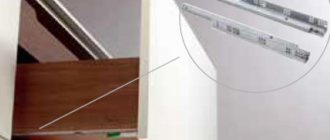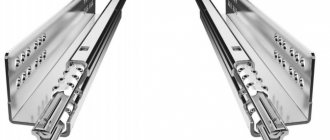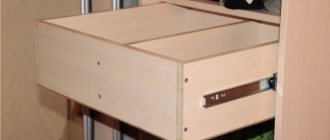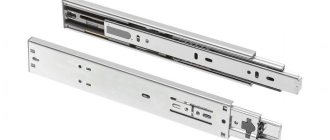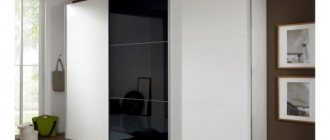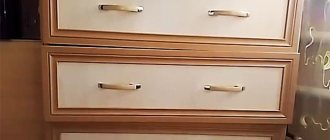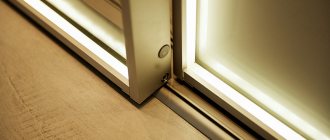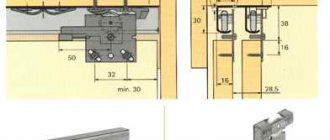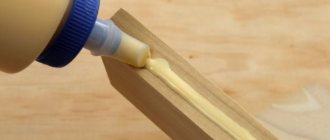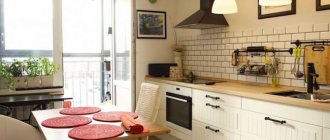Today, most furniture items placed in the living room, children's room, kitchen and bathroom have retractable elements, which are structurally represented by drawers, tabletop extensions, trays and transformable additions. Currently, when installing them, various categories of guides are used, which significantly increase the ergonomics and ease of use of furniture.
Despite the fairly widespread use of sled guides in the form of plastic or wooden blocks, roller and ball guides are becoming increasingly common today.
Despite the simplicity of design, low cost and ease of installation of roller systems, ball devices are considered a worthy alternative. Despite the high price and laid structure, this type of fittings has the following advantages:
- greater smoothness and quiet operation;
- more uniform load distribution across individual rolling elements (balls);
- higher stability, which minimizes drawer distortion;
- greater reliability - even if several balls are defective, the load will be evenly redistributed to the rest.
Features of ball systems
Today, the industry produces double-row and four-row ball guides with full (extra-long) extension. Despite the identical designs, the installation and operation of two-row devices is somewhat different from four-row ones. In addition, the cost of the first category is much lower, and they are designed for a load not exceeding 35.0 kilograms. Despite the widespread use of the first category of products, four-row systems have a longer trouble-free operation period and are able to withstand higher specific loads.
The design of this category of furniture fittings consists of two metal profiles in contact with each other through ball rolling elements. Balls made of steel or nylon are evenly distributed in the recesses of the cradle.
The length of the profile (slot) or its multi-section design allows the drawer to be pulled out to its full depth, so that the back wall is accessible for viewing. To prevent extraction by an unacceptably large amount, this type of device is often additionally equipped with closers or safety latches (stops), which significantly increase the ease of use of retractable tabletops of computer desks.
Installing ball guides: just about simple things
Hello dear friends.
Today we will talk about how the guides are mounted on the side parts of the boxes.
Despite the apparent simplicity of this point, there are small nuances here that we will consider.
It would seem that what could be difficult about this?
I screwed one part of this fitting onto the side of the box (according to a pre-calculated additive map), and the other part onto the drawer. The main thing is not to confuse what to screw where.
But with this approach, it often turns out that in an assembled box, for example, quite noticeable gaps appear somewhere between the box itself and the facades. On this occasion, a nervous correction of the situation begins...
The facades are removed, then fixed in a new way, and... the gaps “pop out” in another place.
I am writing this because the developers of the guides have provided for the possibility of adjusting these guides in two planes. In fact, they are quite universal in terms of their adjustment.
After all, no matter how correctly you calculate a box with drawers, no matter how carefully you assemble it, in the end you will never get an ideal design. Something somewhere is “cosonet”. And this needs to be understood.
This is why, in addition to all our efforts to control the box itself and the drawers for their geometry, sometimes we have to adjust the guides themselves.
So, how to install them correctly, and, if necessary, adjust them?
If you have read previous posts on this blog regarding markings for this fittings, you probably noticed that we mark the axis on the drawer, relative to which we will attach part of the guide - strictly in the center of the drawer.
This makes it easier to calculate the markings for fastening.
When the axis on the drawer is determined, you need to fix the guide runner so that its front edge is almost “flush” with the front part of the drawer (but does not protrude forward, since in this case a gap is formed between the front and the drawer).
For these purposes (upward or forward adjustments), there are oblong holes on the runner itself.
So, let's align it along the axis (make sure that the line drawn with a pencil runs through the center of all the holes of the runner itself).
Then, we put an awl in the hole, stretched along the length of the runner from its front part.
By screwing a self-tapping screw into this place, we are able to adjust it back and forth.
Thus, we select the position we need (as mentioned above - flush with the front edge of the box).
We attach its back part to the hole, which is extended up and down. This is done so that if there is a need to adjust the box itself in height, we will do the following:
- Unscrew the screw from the front adjustment hole (back and forth), from where we screwed it in first
- Screw this self-tapping screw into the hole (up and down), also located in the front part of the runner.
Thus, it turns out that the runner will be attached to the box through two adjustment holes (up and down) in front and behind.
It’s the same story with the installation and adjustment of the part of the guide that is attached to the side of the box itself.
When the box with the drawers and fronts installed in it is finally aligned and adjusted, then we pull out all the drawers and screw the screws into the mounting holes (regular, round) of all the guides on the drawers, and all the guides inside the box.
Yes, on the part of the slide that attaches to the side of the drawer, there are only two adjustable holes (up and down, forward and back) that are located at the front of the drawer.
The rear part contains, in addition to adjustable holes (back and forth), special horizontal and vertical grooves into which self-tapping screws are screwed to adjust it.
Only at this stage is the box with drawers finally assembled.
So, install the ball guides correctly, using every opportunity to adjust them.
See you.
Pros and cons of designs
In addition to the advantages described above, which are characteristic of both two-row and four-row systems, extra-long extension ball fittings have the following advantages:
- A wide range of extension values, which depends on the specific standard size of the product and starts from 150.0 millimeters.
- A variety of colors of non-ferrous metallization, up to antique bronze or gold;
- The presence of a closer makes the operation of these devices absolutely safe.
- Full extension systems, unlike other types of ball guides, provide full inspection of the interior of the drawer without dismantling the holders.
- Possibility of use in special-purpose furniture - workbenches, drawer racks, in various designs of dishwashers, refrigerators and ovens.
- A wide range of full extension guides equipped with additional devices - clamps, facade regulators and other quite useful and ergonomic technical details.
Of course, like any design, this type of furniture fittings has certain, sometimes quite specific, disadvantages. The main disadvantages (besides the high cost) of full extension devices are:
- the impossibility of fixing the extended element in an intermediate position in standard designs;
- demanding maintenance;
- difficulty in matching the color of the furniture - most guides are not painted, but anodized;
- more complex and time-consuming installation, requiring precise markings and careful installation.
How to choose the right guides?
When choosing guides for your furniture, you should pay attention to a number of factors. Due to them, the design ensures silent and smooth opening/closing of the drawer, which can be installed in a wide variety of furniture. When choosing guide structures, pay attention to the following recommendations:
- Installation will be significantly more complicated if the dimensions of the guides do not match the dimensions of the furniture.
- When purchasing guides, pay attention to the thickness of the metal structure (at least 1 - 1.2 mm).
- The appearance of the part must be perfect, without scratches or deformations.
- Make sure that all necessary accessories are included in the kit.
- When choosing tandem boxes, make sure that you can handle the installation yourself. This is a specific design that is installed by specialists.
The choice of guides should be taken seriously, since not only the service life of furniture elements, but also safety and ease of use will depend on your choice. Take our advice into account and choose quality items.
Features of application
In addition to ordinary household furniture products, ball guides have found the widest application in furniture for specific purposes. For example, the tight space of a bathroom does not allow the use of cabinets with standard-length drawers, so fittings that make it possible to fully pull out shallow drawers are suitable here. Due to the noiseless operation, full extension systems are equipped with cabinets in medical institutions, drawer racks for archives, and recording studios, where maintaining silence is one of the working conditions. To make their operation quieter, some manufacturers additionally enclose metal balls in plastic separators.
On a note!
Special guides with a square cross-section often have the option of hidden installation (in a groove), making the fittings completely invisible from the outside. It has found wide application in expensive furniture, the cost of which is not particularly affected by the high price of ball guides.
Many home-made DIYers, making kitchen furniture with their own hands, often use full extension ball fittings for shelving for a small TV or even for a fairly heavy microwave oven.
We invite you to study our master class on attaching ball guides.
Of course, the prevalence of ball guides is significantly influenced by their cost. Today on the furniture fittings market there are various full extension devices made in Russia and China.
- A Russian kit capable of withstanding 45.0...50.0 kilograms (the weight of a microwave oven), having a retractable depth of 400.0...450.0 millimeters, will cost the buyer at least 200.0 rubles.
- Chinese full extension guides with a depth of up to 400.0 millimeters are offered at a price equivalent to 1.0...2.0 US dollars.
The metallization of supports is not caused by the whim of manufacturers, but by operational requirements. For normal, long-term operation of the balls, they require periodic lubrication. Painted surfaces will quickly fail if they come into contact with mineral lubricants.
Today, furniture fittings with the following types of anodized coating go on sale:
- silver or black zinc;
- various shades of bronze;
- polished stainless steel “chrome plated”;
- blackening (oxidation).
In conclusion, I would like to note that the furniture fittings market is quite dynamic and constantly updated. Today you can find lubrication-free ball guides and high-precision systems. So far they have not become widespread in furniture products, but over time, with increasing requirements for comfort and lower prices, they will undoubtedly find their niche in household products.

